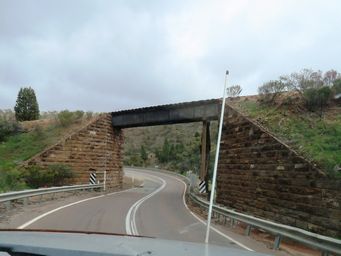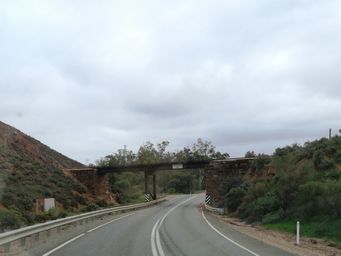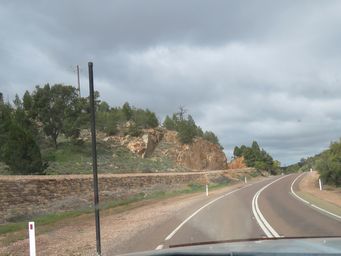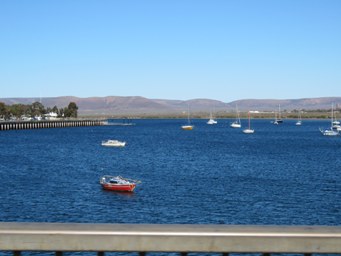Australia So Much to See
Quorn to Port Augusta
Port Augusta City Council allocated $20,000 in its 2018/19 Budget to complete a detailed assessment on the condition of the ageing
wharf. Before agreeing to proceeds, costings were needed.
Marine infrastructure specialists will undertake the assessment
to provide Council with a detailed update regarding the current condition of the Heritage-listed structure.
The wharf is a significant
piece of Port Augusta’s history and highlights the town’s early economic significance, using sea transport in the years before the
railway network was established.
Port Augusta was a pivotal centre through which supplies were imported, with most of the produce passing across the wharf.
During 2000, the State Government of South Australia and the Port Augusta City Council announced that funding was available to extend the Pichi Richi line into Port Augusta station. This has enabled The Afghan Express to run tourist trips from Port Augusta to Quorn as an additional option to the Pichi Richi railway tour between Quorn and Woolshed Flat. This project was completed in 2002.
Considering the terrain, restoration of the narrow gauge line had its difficulty, particularly
as the standard gage line through the same area needed to be kept clear for the coal trains that were then running from Leigh Creek
to Port Augusta.
For over a century Port Augusta's strategic location at the head of Spencer Gulf made it a port for the export of wool, wheat and
minerals from the surrounding inland areas.
However, with the decline in wheat growing after 1884 and the construction
of the Great Northern Railway to Quorn then lines to Farina and Terowie, there was a decline in the port's activities. Freight
which had previously been transported via ship was now being freighted by rail to Adelaide, bypassing Port Augusta. From 1908 provision
ships arrived with railway materials such as sleepers and coal from New South Wales. This ceased in 1955 when road transport
took over. Diesel trains also meant that coal imports were no longer necessary.
Wheat and wool were still exported from Port
Augusta, but instead of special ships being put on, regular visiting vessels took it to Adelaide to be re-loaded for export.
From 1942 coal from Leigh Creek was exported from the port. By 1954 the bulk of wool was freighted by road or rail, and in 1956 the regular weekly shipping service was discontinued. The final blow was the introduction of diesel locomotives by the railway. There were peaks of shipping activity from 1956, but not enough to warrant keeping the port facilities open hence they were closed in 1974.
Sundrop Port Augusta agricultural farm has a substantial tall and solid tower, a few kilometres to the south of Port Augusta near
the Spencer Gulf. The receptors at the top of the tower form a very intense light as the solar is used for power production. This is a private enterprise farm.
This produces energy to power the growing systems and to heat and cool the greenhouses
as required. The tower is 115 metres high and has 23,000 mirrors pointed at it.
Water is used from two sources. Rainwater that
falls on our greenhouses is collected, but Port Augusta has a dry climate. A desalination powered by the solar tower desalinates sea
water for use on the hydroponic fruit and vegetables.
Desalination produces very saline waste water. This saltwater
is cooled, mixed with seawater, and then returned to the sea once the salt levels have returned to normal.
Water is reused and
there is minimal waste. Ventilation also uses seawater to help cool the greenhouses, water is circulated for constant re-use.
Sundrop’s first farm was commenced in in 2010. Here there is no fresh water, there is degraded pasture land and an unforgiving
climate. Could anyone successfully grow produce commercially in such a harsh environment? Research and development, trial and error,
failures and eventual success proved it was. The operation expanded during 2014 to 2016.
All this technology goes
into growing hydroponic tomatoes for Coles Supermarket. The plants flourish on nutrient-rich coconut husks instead of in the soil.
This farm was only made possible by the strong support of government, construction and our debt and equity funding partners.
When the Leigh Creek mines closed in November 2015, the available coal already mined was sent by rail to the Port Augusta power plants. This ceased in April 2016, with the last coal being burnt in May.
In November 2018, this tallest chimney, which dominated
the skyline around Port Augusta, was demolished with explosives. It had been one of the tallest chimneys in Australia, standing
at 200 metres, at the northern power plant. The 80 metre chimney at the southern power plant had been demolished in 2016.
A solar power farm is being constructed around ten kilometres north east of Port Augusta. This is planned to be the largest
polycrystalline solar panel power plant in Australia.
The Lincoln Gap wind farm is on hills to the south west of Port
Augusta, with 59 turbines when all are constructed.
Other renewable energy sources are being constructed to replace
the coal-fired power stations
Woolshed Flat is now a turn around point for the Pichi Richi steam train from Quorn.
Resources
Although well north of the of the Goyder Line, crops were being grown south of Quorn.
The railway from Port Augusta through the Pichi Richi Pass to Quorn opened in 1879, and was part of the first stage of the Great Northern
Railway that was intended to link Port Augusta with Darwin. The Ghan name originated in Quorn in 1923 when the Great Northern Express
was dubbed The Afghan Express by railwaymen. In 1929 this line reached Alice Springs.
The East-West Transcontinental railway
across the Nullarbor Plain was completed in 1917, and the Pichi Richi Railway became part of the East-West route for the next 20 years.
Quorn
was a vital railway junction, especially during World War II when military, coal and other traffic placed sizeable demands on the
railway.
Washaways in the north and the incapacity of the railway to handle expanding traffic saw a new standard gauge railway
constructed from Stirling North to Brachina, and the Pichi Richi Railway was closed to regular traffic in 1957.
The Spencer Gulf at Port Augusta, with the old wharves to left of the boats, and the range on the west side of the gulf beyond.
In 1802, Captain Matthew Flinders was the first European to explore the area around Port Augusta. Forty years later pastoral leases extended from the Flinders Ranges north to Leigh Creek. In the mid 1950s, the prosperous wool merchant and MP, Thomas Elder, initiated the move to survey the harbour and layout the township.
We did not stop a Quorn this time as we had spent some time there before, and we had never been on the right day for the Pichi Richi
steam train which only runs on weekends for much of the year.
There are a number of interesting old buildings in Quorn, including the Old Mill, Town Hall, Railway Station, and former Bank of SA. A Historic Buildings Walk trail incorporates most of the historical buildings



